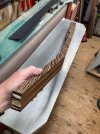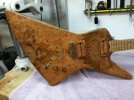Planta Fantasma
Inspired
It's been a few years now since my friends band studio caught fire & mostly burned. The warehouse they played in was rented to multiple bands.
The fire marshals findings were inconclusive as to the cause of the fire & so the insurance company weaseled out of covering anything belonging to the bands.
My friend Dane had his Jackson soloist burn up. It was one of the many items that were unsalvageable from the top floor.
Another friend in a different band room downstairs had major extinguisher damage to his Fryette Two/Ninety/Two power amp. His gear was covered in the long run by his private insurance. He contacted Fryette directly for an insurance replacement quote, & they had him send in the amp to see if it could be salvaged.
These guys are great! They did a set of videos on YouTube going through the amp repair. There are 6 parts in total. Here's a link to where it starts:
A couple common friends who also knew Dane chipped in money for parts & a case. I collected the wood & built him a new guitar.
I found some excellent Swamp Ash for neck & body, 1960's Gaboon Ebony for a fretboard & some awesome (Flame) Red Gum Eucalyptus for the top, no pun intended.
Dane is a lefty, who grew up playing right handed guitars upside down. He never had upper access to the neck until this righty cut for a lefty.
It seems pretty straight forward, but I'm not use to building right handed lefties.........I had to constantly write notes so I wouldn't drill a wrong hole or put dots on the wrong side of the fretboard.
Here are some pictures of Dane's guitar & a link to some of his death metal.
Some folks would argue that the world is a better place without Dane's death metal; however, I know that the world is better for Dane because of his death metal.
Cheers!
The fire marshals findings were inconclusive as to the cause of the fire & so the insurance company weaseled out of covering anything belonging to the bands.
My friend Dane had his Jackson soloist burn up. It was one of the many items that were unsalvageable from the top floor.
Another friend in a different band room downstairs had major extinguisher damage to his Fryette Two/Ninety/Two power amp. His gear was covered in the long run by his private insurance. He contacted Fryette directly for an insurance replacement quote, & they had him send in the amp to see if it could be salvaged.
These guys are great! They did a set of videos on YouTube going through the amp repair. There are 6 parts in total. Here's a link to where it starts:
A couple common friends who also knew Dane chipped in money for parts & a case. I collected the wood & built him a new guitar.
I found some excellent Swamp Ash for neck & body, 1960's Gaboon Ebony for a fretboard & some awesome (Flame) Red Gum Eucalyptus for the top, no pun intended.
Dane is a lefty, who grew up playing right handed guitars upside down. He never had upper access to the neck until this righty cut for a lefty.
It seems pretty straight forward, but I'm not use to building right handed lefties.........I had to constantly write notes so I wouldn't drill a wrong hole or put dots on the wrong side of the fretboard.
Here are some pictures of Dane's guitar & a link to some of his death metal.
Some folks would argue that the world is a better place without Dane's death metal; however, I know that the world is better for Dane because of his death metal.

Cheers!
Attachments
-
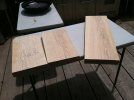 IMG_0336.JPG1.7 MB · Views: 51
IMG_0336.JPG1.7 MB · Views: 51 -
 IMG_0543.JPG799.3 KB · Views: 55
IMG_0543.JPG799.3 KB · Views: 55 -
 IMG_0539.JPG2.1 MB · Views: 49
IMG_0539.JPG2.1 MB · Views: 49 -
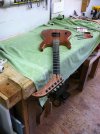 IMG_0537.JPG2.1 MB · Views: 42
IMG_0537.JPG2.1 MB · Views: 42 -
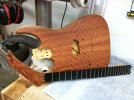 IMG_0512.JPG1.9 MB · Views: 42
IMG_0512.JPG1.9 MB · Views: 42 -
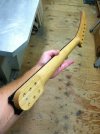 IMG_0508.JPG1.9 MB · Views: 38
IMG_0508.JPG1.9 MB · Views: 38 -
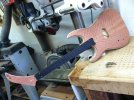 IMG_0426.JPG2 MB · Views: 37
IMG_0426.JPG2 MB · Views: 37 -
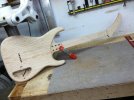 IMG_0404.JPG2.1 MB · Views: 36
IMG_0404.JPG2.1 MB · Views: 36 -
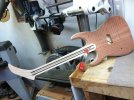 IMG_0403.JPG1.9 MB · Views: 35
IMG_0403.JPG1.9 MB · Views: 35 -
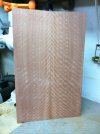 IMG_0363.JPG2 MB · Views: 38
IMG_0363.JPG2 MB · Views: 38





